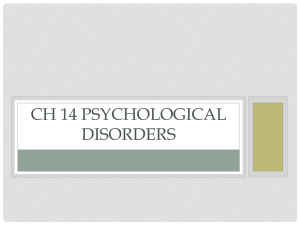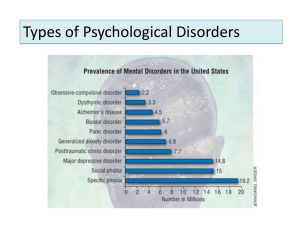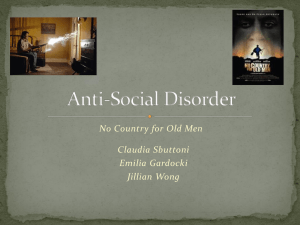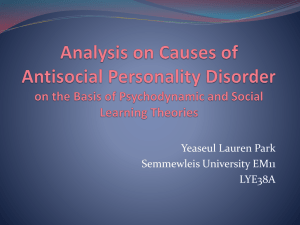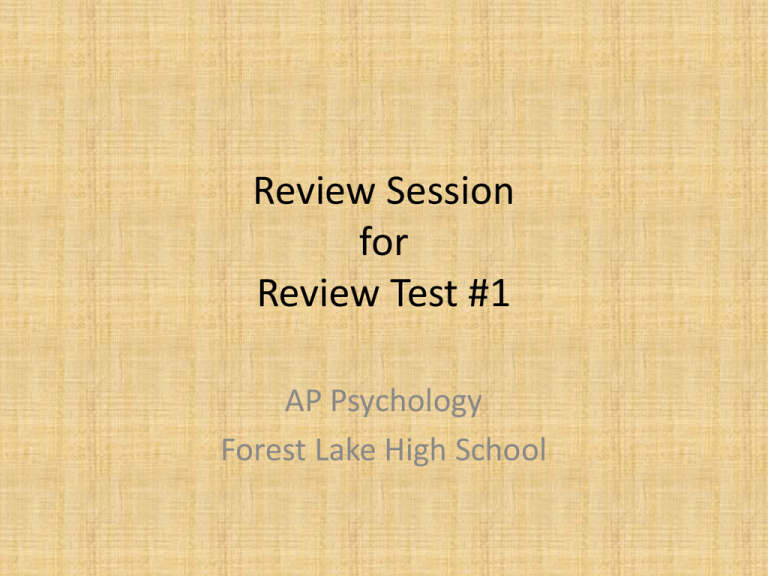
Review Session
for
Review Test #1
AP Psychology
Forest Lake High School
Question #1
Hartshorne and May conducted a famous set of experiments in which they
tested children’s honesty. They found that virtually everyone was honest in
some situations and dishonest in others. This type of finding presents the
greatest challenge to what type of personality theorist?
A.
B.
C.
D.
E.
Social cognitive
Trait
Psychoanalytic
Humanistic
Behaviorist
B – Trait theorists describe personality with a set of characteristics that
presumably should hold fairly constant across a wide variety of
circumstances. If you say someone is conscientious, you typically don’t
mean that the person works hard in some situations and not in others.
The other approaches all embrace the idea that the environment plays
some role in shaping behavior and personality.
Question #2
Which of the following is one of the Big Five?
A.
B.
C.
D.
E.
Identification
Narcissism
Egotism
Openness
Temperament
D – The Big Five personality traits are: openness,
agreeableness, conscientiousness, extraversion, and
neuroticism.
Question #3
Dimitri invents a new way to assess personality that involves describing
the images one sees in a carefully selected set of photographs of
clouds. Which type of psychologist is most likely to find such an
assessment useful?
A.
B.
C.
D.
E.
Humanistic
Cognitive
Behavioral
Trait
Psychoanalytic
E – Dimitri’s cloud test is an example of a projective test. Similar to the
TAT and Rorshach tests, it is likely based on the idea that what
people project onto ambiguous stimuli provide insight into their
personalities.
Question #4
Alarmed by her penchant for schoolyard fights, Cherry’s parents
encouraged her interest in Tae Kwon Do. Now a college student,
Cherry has a black belt, teaches at the local dojo and hasn’t had a fight
in over a decade. This story could be seen as an example of
A.
B.
C.
D.
E.
Projection
Sublimation
Displacement
Regression
Rationalization
B – Sublimation is a Freudian defense mechanism that suggests that
people take unacceptable feelings and desires (in this case a desire
to be violent) and channel them into more socially acceptable
pursuits.
Question #5
According to Freud, during which stage is the superego
formed?
A.
B.
C.
D.
E.
Oral
Anal
Phallic
Latency
Genital
C – Freud asserted that the superego, essentially an
individual’s conscience, formed during the phallic stage
(ages 3-5), largely as the result of the Oedipal crisis.
Question #6
Carl Jung is credited with introducing which of the following ideas?
A.
B.
C.
D.
E.
Inferiority complex
Womb envy
Collective unconscious
Self-actualization
Factor analysis
C – Jung proposed that people inherit a kind of collective unconscious
for the human species that is a repository for common important
ideas that he called archetypes. The idea of an inferiority complex is
credited to Alfred Adler; womb envy is a term coined by Karen
Horney; self-actualization is associated with Abraham Maslow, and
factor analysis is a statistical technique first developed by Charles
Spearman.
Question #7
Which of the following best describes the basic idea behind Bandura’s
reciprocal determinism?
A.
B.
C.
D.
E.
Personality is the result of the interplay between behavior, traits, and
the environment.
Important things tend to happen in threes and have a cumulative impact
on our lives
Exposure to uncontrollable situations results in a feeling of helplessness
even when one can control ones circumstances
People tend to treat others in similar ways to how they have been
treated
People often misdirect their emotions and take them out on people who
do not deserve them
A – Bandura suggested that personality results from a set of two-way
influences between one’s behaviors, traits, and the environment. This idea
is known as reciprocal determinism or triadic reciprocality.
Question #8
Carl Rogers said that the ___________ is (are) an innate drive
that motivates all human behavior toward growth.
A.
B.
C.
D.
E.
Unconscious
Central traits
Actualizing tendency
Wish fulfillment
Ego
C – Carl Rogers believed that people have an actualizing
tendency that is an innate drive that guides behavior
resulting in personality
Question #9
Which brain structure most directly control the desire to eat and
feelings of fullness?
A.
B.
C.
D.
E.
sensory cortex
thalamus
hypothalamus
pons
frontal lobe
C - The lateral and ventromedial hypothalamus control our desire to
eat and the feeling of fullness that influences us to stop eating. Rats
with lesions in either of these areas either never stop eating or
never desire food unless food is removed.
Question #10
Which management theory is most likely to help employees grow
toward self-actualization?
A.
B.
C.
D.
E.
Theory X
Theory Y
Drive-reduction
Opponent process
Achievement motivation
B - The two management theories described by motivation
psychologists are theory X and theory Y management theories.
Theory X managers use rewards and punishments to coerce
employees into working. Theory Y managers assume, like Maslow,
that employees are intrinsically motivated and managers should
work to inspire and enable employees to work.
Question #11
One of the major variables that mitigates the harmful
effects of stress is what?
A.
B.
C.
D.
E.
homeostasis
perceived control
achievement motivation
primary drives
self-actualization
B - Many studies indicate that animals (including humans)
who perceive that they have control over a situation
experience fewer harmful effects from stress.
Question #12
A drastic change in set-point would most affect which human
behavior?
A.
B.
C.
D.
E.
self-actualization
achievement
eating
aggression
Arousal
C - Set-point theory describes the behavior of the hypothalamus in
influencing our eating. This theory predicts that the hypothalamus
tries to maintain a specific body weight, a set point, and when we
are below that point it triggers hunger impulses and lowers our
metabolic rate.
Question #13
What is the major difference between the James-Lange, the Canon-Bard, and
the two-factor theories of emotions?
A.
B.
C.
D.
E.
the role stress plays in causing powerful emotions
each of the theories describes a different set-point for emotions
the sequence of environmental event, physiological reaction, and
emotional experience
the relative importance of intrinsic and extrinsic factors on the cognitive
experience of emotion
each of the theories predicts different brain areas as the origin of
emotions
C - These theories primarily differ in how they describe the sequence of the
emotional process. The James-Lange theory holds that physiological
reactions occur first, the Canon-Bard theory holds that the emotional
experience precedes the physiological reaction, and the two-factor theory
explains the interactions between them as they occur simultaneously.
Question #14
A basketball coach is interested in how excited or relaxed her team
should be before a game. She wants their excitement level to be
exactly right so that they perform their best during the game. Which
psychological concept should this coach research?
A.
B.
C.
D.
E.
Extrinsic motivators
Two-factor theory
Drive reduction theory
Opponent-process theory
Yerkes-Dodson law
E - The Yerkes-Dodson law describes how physiological arousal impacts
performance. Both very low and very high levels of arousal usually
negatively impact performance.
Question #15
Suzy has started to consume less and less food. She also spends three
to four hours at the gym working out each day. The mention of food
upsets her, and she won’t listen to anybody who suggests that she is
not eating enough. Suzy may be suffering from
A.
B.
C.
D.
E.
Anorexia nervosa
Bulimia nervosa
The misinformation effect
Serial processing
The egocentrism effect
A – Anorexia nervosa is an eating disorder characterized by a lack of
caloric intake, vigorous exercise, and a fear of gaining weight.
Question #16
When Julie heard a noise outside her window, her heart
started to beat faster, and as a result she became scared.
Which theory of emotion could best explain Julie’s
response of fear?
A.
B.
C.
D.
E.
Cannon-Bard theory of emotion
James-Lange theory of emotion
Two-factor theory of emotion
Cognitive-Meditational theory of emotion
Facial-feedback hypothesis
B – The James-Lange theory of emotion states that emotions
are the result of physiological changes in the body.
Question #17
Paulene typically experiences feelings of autonomic nervous
system arousal. With which type or disorder is this symptom
most closely associated?
A.
B.
C.
D.
E.
Schizophrenic
Mood
Anxiety
Somatoform
Dissociative
C – Paulene seems to suffer from generalized anxiety disorder
(GAD), a type of anxiety disorder. Autonomic arousal causes
feelings of anxiety or nervousness.
Question #18
According to a behaviorist, psychological disorders are largely caused
by
A.
B.
C.
D.
E.
Contingencies of reinforcement
Neurochemical imbalances in the brain
Maladaptive ways of thinking
Unmet psychological needs
Repressed traumas from childhood
A – Behaviorists believe that the reinforcement contingencies to which
one has been exposed shape one’s behaviors. A biopsychologist
would link the source of the problem to neurochemicals, cognitive
psychologists would fault maladaptive ways of thinking, humanistic
psychologists would speak of psychological needs, and
psychoanalysts would likely blame repressed childhood traumas.
Question #19
Which of the following is an example of a delusion?
A.
B.
C.
D.
E.
Hearing the neighbor’s dog talking to you
Seeing people that you know are dead
Imagining that you hold an important government position
Taking precautions to prevent people from tampering with your
food
Talking to yourself
C – Delusions are false beliefs. Thus, imagining you hold an important
government position is a delusion. Choices A and B describe
hallucinations – perceiving sensory experiences that do not exist. D
and E both represent behaviors one might take in response to a
delusion, but they are not themselves delusions.
Question #20
Which of the following disorders is thought to be the most highly
heritable?
A.
B.
C.
D.
E.
Panic disorder
Unipolar depression
Dissociative identity disorder
Borderline personality disorder
Bipolar disorder
E – The term heritability refers to the percent of the variation in a trait
due to genetic influences. Bipolar disorder, formerly known as
manic-depression, is thought to highly heritable based on evidence
from twin and other family studies.
Question #21
Jethro frequently feels the need to check and double-check whether
he has remembered to turn the oven off in the morning. This checking
would best be described as an example of
A.
B.
C.
D.
E.
An obsession
A personality disorder
Paranoia
Anxiety
A compulsion
E – Compulsions are repetitive, unwanted behaviors designed to
relieve the anxiety caused by obsessions. Presumably, Jethro is
worried that something bad will happen (for instance, a fire)
because he has left the oven on each morning and feels driven to
perform then checking behavior in order to alleviate that anxiety.
Question #22
Enlarged brain ventricles are a symptom of what mental disorder?
A.
B.
C.
D.
E.
Schizophrenia
Conversion disorder
OCD
ADHD
Anorexia nervosa
A – Schizophrenia has been shown to be linked to enlarged brain
ventricles. Everyone has spaces in their brain called ventricles which
are filled with cerebrospinal fluid, but scans have indicated that, in
people who suffer from schizophrenia, these spaces are enlarged.
Question #23
Psychologists often disagree about exactly what to include in the DSM. What
argument is often made in favor of a more comprehensive listing?
A.
B.
C.
D.
E.
Labeling a person’s problem is an important first step toward solving it
Insurance companies will not cover treatment for something not listed in
the DSM
American society no longer stigmatizes those who have been classified
as having a mental illness.
A more detailed manual will make the diagnostic process easier.
People like to find descriptions in the book that match the problems they
think they have.
B – Without a diagnosis, insurance companies will not provide coverage for
treatment. Therefore, many psychologists have argued that it is better to
be overly broad in what is included in the DSM (Diagnostic and Statistical
Manual of Mental Disorders) than too narrow. Labeling and the stigma
associated with having a label are often thought to be reasons against
classifying more things as disorders.
Question #24
Mental retardation would be listed on which axis of the DSM-IV-TR?
A.
B.
C.
D.
E.
Axis I
Axis II
Axis III
Axis IV
Axis V
B – Personality Disorders and mental retardation are listed on Axis II of
the DSM-IV-TR. Axis I lists major clinical disorders, Axis III is for
general medical conditions, Axis IV is for relevant psychosocial or
environmental factors, Axis V is a global assessment of functioning
(on a scale of 1-100)
Question #25
Dr. Sturge asks patients to blurt out whatever is on their minds and to
describe their dreams. What is the likely purpose of these types of
techniques?
A.
B.
C.
D.
E.
To relieve feelings of anxiety in the short term
To learn about the patients’ families and friends
To uncover repressed thoughts
To correct the patients’ irrational thoughts
To put the patients at ease
C – The techniques described are commonly used by psychoanalytic and
psychodynamic therapists to reveal the threatening thoughts people have
repressed into their unconscious. While a long term goal of such
techniques is that they will lead to insight that will ultimately relieve
anxiety and while the processes may also involve in the disclosure of
information about a person’s family or friends, the immediate goal is to
help the therapist to gain insight into what the client might be repressing.
Question #26
Electroconvulsive shock therapy is most often employed to treat
A.
B.
C.
D.
E.
Agoraphobia
Dissociative amnesia
Antisocial personality disorder
Unipolar depression
Autism
D – Electroconvulsive shock therapy or ECT is most commonly used to
treat people suffering from severe depression especially when the
depression has not been alleviated by other types of less invasive
treatments.
Question #27
Mr. Mather’s kindergarten class is completely out of control. He can’t get the
5-year olds to sit in their seats long enough to teach them anything. One
Monday, Mr. Ziller comes in with an enormous container of colored buttons
and announces that every time he sees someone doing something good, the
student will get a button. At the end of the week, buttons will be able to be
exchanged at Mr. Mather’s Market. What technique is Mr. Mather using?
A.
B.
C.
D.
E.
Reverse psychology
Eclectism
Token economy
Aversive conditioning
Group therapy
C – A token economy is a system in which generalized reinforcers (tokens) are
used to quickly and easily reinforce desired behaviors. The value of these
reinforcers comes from being able to trade them in at a later time for
objects or privileges of an individual’s own choosing.
Question #28
Ajay tells his therapist that he feels lonely and isolated. His therapist says, “So,
you seem to be feeling alone. Tell me more about that.” This comment
suggests that the therapist is most likely using what type of therapy?
A.
B.
C.
D.
E.
Psychodynamic
Person-centered
Implosive
Cognitive therapy
Psychoanalytic
B – Carl Rogers person- or client-centered therapy is a nondirective,
humanistic, insight therapy that aims to help people identify their own
problems. As such, the therapist’s job is mainly to listen actively and act as
a mirror to reflect back what the client is saying and thereby help him/her
recognize the issue.
Question #29
Counterconditioning is a key part of which therapeutic approach?
A.
B.
C.
D.
E.
Psychoanalyisis
Systematic desensitization
Rational emotive behavior therapy
Insight therapy
Family therapy
B – Counterconditioning is the replacement of one type of learned
response with another and is a key part of systematic
desensitization, a common treatment for phobias. In using
systematic desensitization with a phobic individual, the goal is to
replace the anxiety felt in response to the feared object with a
feeling of relaxation.
Question #30
Many antidepressants work by
A.
B.
C.
D.
E.
Increasing the amount of norepinephrine in the synapse
Decreasing the amount of serotonin in the synapse
Increasing the amount of dopamine in the synapse
Decreasing the amount of acetylcholine in the synapse
Increasing the amount of GABA in the synapse
A – Depression has been linked to low levels of both
norepinephrine and serotonin. As a result, a number of
antidepressants have been designed to elevate levels of
these neurotransmitters in the synapse.
Question #31
Which of the following drugs would be most likely be prescribed for a
patient who suffers from manic episodes?
A.
B.
C.
D.
E.
Haldol
Chlorpromazine
Benzodiazepines
Barbiturates
Lithium
E – Lithium is often prescribed to treat bipolar disorder, especially the
manic episodes that often occur as part of that disorder. Haldol and
chlorpromazine are antipsychotic medications, and benzodiazepines
and barbiturates are more often used as anti-anxiety medications.
Question #32
Initially, Joey did not like watching Sesame Street. After his
Dad put it on repeatedly, Joey came to love it. Joey’s change
of heart is best explained to
A.
B.
C.
D.
E.
Classical conditioning
The mere exposure effect
The fundamental attribution error
Maturation
The law of effect
B – The mere exposure effect says that exposure breeds
fondness. Thus, the more Joey watched Sesame Street, the
more he came to like it.
Question #33
Research has shown that people are more likely to complete a survey if they
are given a token incentive along with the survey than a larger incentive that
will be given to them upon the survey’s completion. Which phenomenon
provides an explanation for this finding?
A.
B.
C.
D.
E.
Norms of reciprocity
Positive reinforcement
Intrinsic motivation
Foot-in-the-door
Prosocial behavior
A – When you give someone a gift – even one of very token value - you
engage what seems to be a natural response to reciprocate in kind. This
norm of reciprocity explains why the prepayment of an incentive seems to
work better than a promised post-payment even of greater value.
Question #34
Which experiment illustrated the power of the self-fulfilling prophecy?
A.
B.
C.
D.
E.
Milgram’s experiment involving electric shock and learning
Asch’s experiment on visual perception
Rosenthal and Jacobson’s study of elementary children
Darley and Latane’s good samaritan experiment
Bandura’s Bobo Doll study
C – Rosenthal and Jacobson’s experiment illustrated that when
elementary school teachers were told that some of their students
would experience a big year in their academic development, they
did, indeed, develop more rapidly than their peers. The power of
one person’s expectations to cause behavioral confirmation in
another person is known as a self-fulfilling prophecy.
Question #35
The bystander effect most nearly states that
A.
B.
C.
D.
E.
People are drawn to gape at other people’s misfortunes
Bystanders are likely to imitate the behavior of other bystanders they
can see
The fewer people present when someone needs help, the more likely
any one is to help
An excessive number of bystanders causes people to act in a dangerous
and unpredictable manner
The presence of bystanders causes heightened sensitivity to workers’
behavior
C – Darley and Latane were the first to show that the more people who
observe someone who needs help, the less likely any one of them is to
help; this idea is known as the bystander effect and is usually explained by
the idea that there is a diffusion of responsibility amongst the bystanders.
Question #36
Jeffrey often forgets something on his way to school – his glasses, his
homework, his trumpet. When Jeffrey turns up without his permission slip for
the class trip to the zoo, his teacher, Mr. Perkins, will most likely conclude that
A.
B.
C.
D.
E.
Jeffrey had a very chaotic morning
Jeffrey is a disorganized person
Jeffrey doesn’t really want to go on the trip
Jeffrey is likely sick
Jeffrey is not very intelligent
B – Mr. Perkins is likely to make a person-stable attribution – an attribution
that explains Jeffrey’s behavior as a logical outgrowth of something
internal and fairly consistent within him. The only choices that fall into
that category are B and E. It seems more logical that to blame Jeffrey’s
lack of a permission slip on disorganization than on intelligence.
Question #37
Will, who loves Shakespearean drama, vastly overestimates the
number of people who share his love of the Bard. This is an example
of
A.
B.
C.
D.
E.
Self-serving bias
A stable attribution
Conformity
A self-fulfilling prophecy
The false consensus effect
E – The false consensus effect is the tendency to overestimate the
number of people who agree with us. Therefore, Will’s fondness for
Shakespeare is likely to lead him to overestimate the number of
people who share this view.
Question #38
Ms. Stern is a newly hired English teacher. Which of the following factors
would make it most likely that she is embraced and accepted by the rest of
the teachers in the department?
A.
B.
C.
D.
E.
If she has a great deal of subject matter expertise
If her students like and respect her
If the teachers have a common area in which they spend their free time
If she brings a unique set of qualities that complement those of the rest
of the department
If she frequently expresses happiness with her new job
C – One of the best predictors of whether people will like each other is
proximity – their opportunity to be close to each other. It is therefore
more important that the teachers be given an opportunity to associate
with Ms. Stern than how her students feel about her or what her personal
qualities are.
Question #39
All of the following are examples of factors that exacerbate the societal
problem of prejudice EXCEPT
A.
B.
C.
People seem to have a natural inclination to categorize others
Many biases are unconscious
From an early age, children model the behaviors of those around
them
D. People from different backgrounds are often attracted to one
another
E. People prefer their in-groups to out-groups
D – Contrary to much popular lore, people are typically more attracted
to those who are similar to them as opposed to their “opposites.” In
addition, if people were attracted to their opposites, this
phenomenon would help deter rather than encourage prejudice.
Question #40
While the entire class was singing “Happy Birthday” to Jared, Mica was
moving his lips but was not singing. Because there were already 28
people singing, Mica didn’t feel that he needed to sing as well. This
group phenomenon is known as
A.
B.
C.
D.
E.
Cognitive dissonance
Social facilitation
Social striving
Social loafing
Social normation
D – Social loafing occurs when one person doesn’t put forth his full
effort because there are other people that he assumes will
compensate for his slacking off

